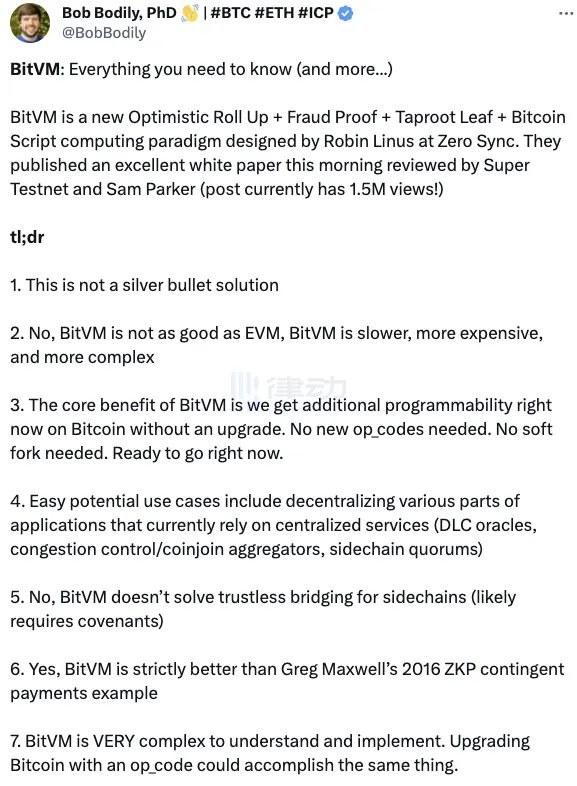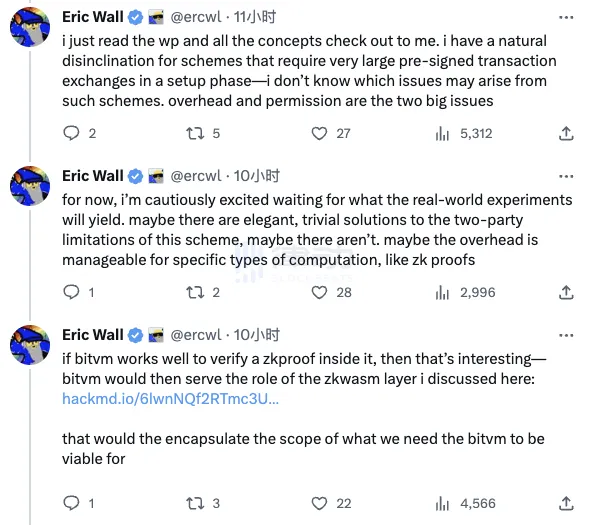BitVM whitepaper released, how do senior developers view the vision of computing any content on Bitcoin?
BitVM whitepaper released, senior developers' views on computing any content on Bitcoin.Author: Jaleel, BlockBeats
Last night, the project leader of ZeroSync released a white paper titled “BitVM: Compute Anything on Bitcoin”, which has sparked a heated discussion.
In this white paper, audited by Super Testnet and Sam LianGuairker, it can be seen that BitVM is a new computational paradigm designed by Robin Linus in Zero Sync, combining Optimistic Roll Up, Fraud Proof, Taproot Leaf, and Bitcoin Script.
BitVM allows for the expression of Turing-complete Bitcoin contracts without changing the consensus rules of the Bitcoin network. It can execute any computable function, perform offline calculations, and leave no trace on the chain. The white paper also introduces the architecture, input/output, limitations, and prospects of BitVM.
- NFT market frozen to the freezing point, can Yuga Labs regain its glory through gaming?
- 5 must-read articles in the evening | Understanding Bitcoin’s on-chain performance in September with one article
- Interpreting BitVM Bitcoin can achieve arbitrary computation without the need for forking
Just one hour after the release of the white paper, it reached 110,000 views. As of the time of writing, the number of views has reached 1.82 million. The discussion in the English-speaking community has been exceptionally heated, making it one of the biggest hot topics in the crypto world recently. KOL @LeonidasNFT believes that this is an exciting innovation and has engraved the BitVM paper on a Bitcoin inscription, making it exist in a more native way.
What do Bitcoin developers think?
The Bitcoin ecosystem has been particularly lively this year, with Ordinals Market spawning many extended narratives about Bitcoin, and Bitcoin developers have been exceptionally lively as well.
Bob Bodily, CEO of BioniqMarket, who is currently focused on the Ordinals marketplace and the launch of LianGuaid, has been building tools to help developers build on Bitcoin. He said on his social media: “BitVM is not a one-size-fits-all solution. BitVM is not as good as EVM; it is slower, more expensive, and more complex. The core advantage of BitVM is that we can now obtain additional programmability on Bitcoin without the need for upgrades. No need for new op_codes. No need for a soft fork. It can be used now.”
Bob Bodily also stated: “Potential use cases that are easy to implement with BitVM include partial decentralization of various applications that currently rely on centralized services, including DLC oracles, congestion control/coinjoin aggregators, and sidechain legal numbers. In addition, BitVM does not solve the problem of trustless bridging for sidechains, which may require contracts. BitVM is strictly superior to Greg Maxwell’s 2016 ZKP conditional payment demonstration. BitVM is very complex, and both understanding and implementation are difficult. The same thing can be achieved by upgrading Bitcoin through an op_code.”
Bitcoin doesn’t need any changes
Researcher Sam LianGuairker believes that BitVM has the potential to provide more programming capabilities without modifying the Bitcoin protocol, and how this capability can help decentralization and eliminate the need for trust in third parties. At the same time, he also mentioned that this is an optional feature, and the Bitcoin community and users can choose whether and how to use this feature.
In a long tweet, Sam LianGuairker wrote: “To reiterate, Bitcoin now has Turing completeness just like any other chain, and this does not require any changes to Bitcoin. Some of the classic views of Bitcoin maximalists when “pointing the country” are: Turing completeness = bad, which I think is foolish. First of all, because the technical definition of Turing completeness actually requires infinite runtime, nothing in our reality will ever truly achieve Turing completeness because we don’t have infinite space and time to accommodate it.”
Regarding the content of the BitVM white paper, Sam LianGuairker said: “In this process, a small group of script hackers, such as @robin_linus and @super_testnet, have found a way to encode all the functionality we want from a general-purpose computer into Bitcoin’s extremely limited set of operation codes. Therefore, the only thing that prevents Bitcoin’s virtual machine (VM) from being Turing complete like Ethereum is not a matter of expressive power, but simply a matter of runtime, with the strictest limitation being the stack size.”
All BitVM does is allow us to distribute the runtime of certain logic, which exceeds the scope of a single transaction, across multiple transactions. That’s it. We haven’t added any new semantic features, we’ve just exponentially increased the length of the programs we can run. So, according to the technical definition, Bitcoin is actually no more Turing complete than before, it simply has a runtime assigned to it in programs that we can reasonably say are “Turing complete enough for any program we actually want to execute.”
This is voluntary. If you don’t trust your coins to be locked into a Turing complete contract (which is completely reasonable), then don’t lock them into a Turing complete smart contract. One advantage of the UTXO system is secure sandboxing. If people do strongly believe that Bitcoin should not have this feature, perhaps due to incentives or other issues, then this should be a discussion worth having, but basically it would require getting rid of Taproot, which looks very foolish at this time.” Sam LianGuairker wrote.
“BitVM gives me a cautiously excited feeling”
As a strong supporter of the Drivechains Bitcoin extension protocol, Simp DAO founder and crypto senior researcher Eric Wall was invited by community members to express his views on BitVM. Eric Wall said: “I just finished reading this white paper, and all the concepts seem appropriate to me. I am naturally not interested in schemes that require a significant amount of pre-signed transaction exchanges during the setup phase—I don’t know what problems such schemes might create. The two big issues are additional resource consumption (overhead) and permissions.”
Now he maintains a cautious excitement about BitVM and waits to see what practical experiments will bring. Perhaps there are elegant and insignificant solutions to the limitations of this scheme, or perhaps not. Perhaps the cost is manageable for specific types of calculations, such as zk proofs. If BitVM works well in verifying zk proofs, it will be interesting – BitVM will play the role of the zkwasm layer he previously discussed.
“As a side note, I’m curious about what will happen when people realize that the attack model is quite similar to Drivechains. Miners can steal all the balance of BitVM by colluding with the provers and reviewing the challenges, and this situation may last for a shorter period of time than in Drivechains.” Eric Wall wrote.
By allowing Turing-complete contracts to be expressed on the Bitcoin network without leaving a trace on the chain, BitVM provides a new way to explore complex blockchain computations while maintaining the principles and security of the Bitcoin network. This also allows Bitcoin to embrace broader use cases and possibilities for innovation without directly modifying its core protocol.
It is also noteworthy that BitVM has sparked in-depth discussions about the design and evolution of Bitcoin. How it will be implemented and play a role in the Bitcoin network in the future will be an extremely exciting technological exploration. This also raises a critical question: Are we ready to expand Bitcoin from a digital currency primarily used for storage and transactions to a global platform capable of conducting more extensive and complex computations? This also prompts us to think more deeply about the future form of Bitcoin that we desire – whether Bitcoin should add more “native” programmability or continue to maintain simplicity, security, and immutability.
References
1. BitVM Whitepaper
We will continue to update Blocking; if you have any questions or suggestions, please contact us!
Was this article helpful?
93 out of 132 found this helpful
Related articles
- US House of Representatives ‘Leaderless’, Cryptocurrency Legislation May Stall
- Follow-up analysis of the Grayscale case Will the US SEC fully approve a Bitcoin spot ETF in January next year?
- My First Principles Thinking on the Blockchain Industry
- When can we buy at the bottom? Just like waiting for the fish to die in the market.
- Analyst The difference in bull and bear market returns between BTC and ETH can be ignored.
- Galaxy Report The Revolution of Bitcoin Itself
- Bitget Survey Chinese Investors Have Higher Investments in Cryptocurrencies








